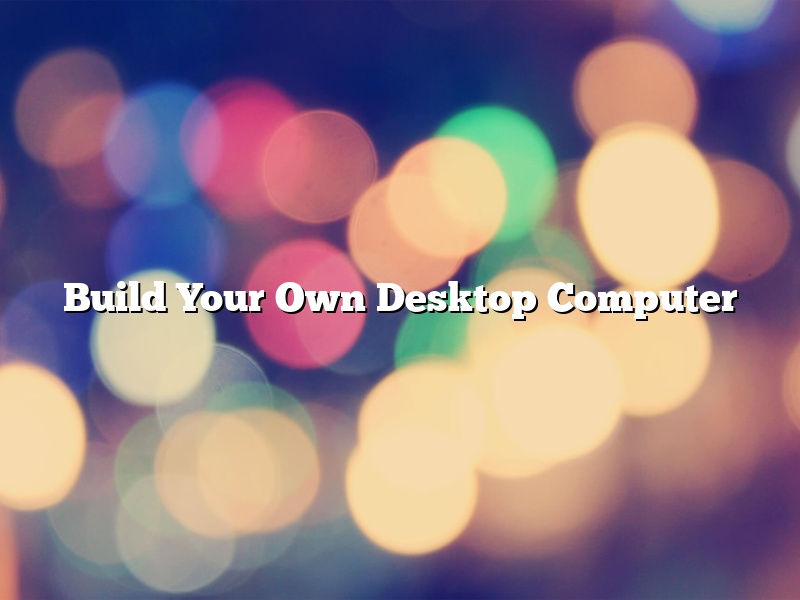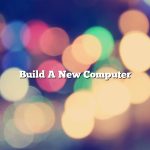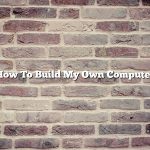A desktop computer is a personal computer (PC) in a form factor that is larger than a laptop. Desktop computers typically have the following components: a display, a central processing unit (CPU), a keyboard, a mouse, and an audio output.
Building your own desktop computer can be a fun and rewarding experience. Not only will you save money, but you’ll also have a system that is tailored to your specific needs. In this article, we will discuss the benefits of building your own desktop computer, the components you’ll need, and how to put it all together.
Benefits of Building Your Own Desktop Computer
There are several benefits to building your own desktop computer:
1. You’ll save money.
Building your own desktop computer is significantly cheaper than buying a pre-built system. By assembling the system yourself, you can choose the components that best fit your needs and budget.
2. You’ll have a system that is tailored to your needs.
Desktop computers come in a variety of form factors and configurations. You can choose the components that best fit your needs, including the CPU, graphics card, amount of RAM, and hard drive size.
3. You’ll learn about the inner workings of a computer.
Building your own desktop computer is a great way to learn about the inner workings of a computer. This knowledge can be valuable when it comes time to troubleshoot problems or upgrade your system.
4. It’s a fun project.
Building your own desktop computer can be a fun and rewarding project. Not only will you have a system that meets your specific needs, but you’ll also have the satisfaction of knowing that you built it yourself.
Components You’ll Need
There are a few components you’ll need in order to build your own desktop computer:
1. A case.
The case is the enclosure that holds all of the computer’s components. There are a variety of cases to choose from, including mini-tower, mid-tower, and full-tower cases.
2. A motherboard.
The motherboard is the main circuit board in a computer. It contains the CPU, RAM, graphics card slots, and other important components.
3. A CPU.
The Central Processing Unit, or CPU, is the brains of the computer. It performs all of the calculations and tasks that the computer is tasked with.
4. A graphics card.
The graphics card is responsible for rendering the images on the computer’s display. There are a variety of graphics cards to choose from, including budget cards and high-end cards.
5. RAM.
Random Access Memory, or RAM, is used to store data that is currently being used by the computer. The more RAM you have, the more tasks you can perform at the same time.
6. A hard drive.
The hard drive is where the computer stores its data. There are a variety of hard drive sizes to choose from, including 1TB, 2TB, and 3TB models.
7. An optical drive.
The optical drive is used to read and write optical discs, such as CDs and DVDs.
8. A power supply.
The power supply provides power to the computer’s components. It is important to select a power supply that is compatible with the components you choose.
9. A motherboard chipset cooler.
Some motherboards come with a chipset cooler, which is used to cool the motherboard’s chipset. If your motherboard does not come with a chipset cooler, you’ll need to purchase one
Contents [hide]
Is it cheaper to build your own computer?
There are many factors to consider when deciding whether or not to build your own computer. The most important cost considerations are the price of the individual components and the time it would take to build the computer.
Components for a custom computer can be purchased from a variety of sources, both online and in physical stores. The prices for components vary, but can be cheaper if bought in bulk or during a sale. It can also be cheaper to build a computer with components that are specific to your needs, as opposed to using off-the-shelf parts.
Building a computer can be a time-consuming process, especially for those who are not familiar with the process. It can take upwards of an hour to assemble a computer, and even more time to install the operating system and necessary software. There are a number of online resources that can walk you through the process of building a computer, but it is still a challenge for some people.
Overall, it can be cheaper to build your own computer, but the price savings may not be significant for some people. The time commitment and level of difficulty may also be deterrents for some people.
Is building your own PC cheaper than pre-built?
It’s a question that’s been asked for years – is building your own PC cheaper than buying a pre-built model?
The answer is a little complicated. In some cases, it is cheaper to build your own PC. However, in other cases, it’s cheaper to buy a pre-built model.
The main reason for this is that the cost of parts changes all the time. A graphics card that was expensive a year ago may now be much cheaper, while a processor that was once a bargain may now be more expensive.
As a general rule, it’s usually cheaper to build your own PC if you’re looking for a high-end model. If you’re after a low- to mid-range system, it may be cheaper to buy a pre-built model.
There are a few things to keep in mind when building your own PC. Make sure you factor in the cost of the operating system, as this can be expensive. You’ll also need to purchase a PC case, a power supply, and a motherboard.
If you’re not confident building your own PC, there are a number of companies that offer custom PC building services. This can be a good option if you want a high-end system but don’t want to deal with the hassle of building it yourself.
What is the best website to build your own PC?
There are a lot of websites that allow you to build your own PC, but not all of them are created equal. Some sites are more user-friendly than others, and some are more affordable. So, what is the best website to build your own PC?
There are a few different factors to consider when choosing a website to build your PC. The first is affordability. Some websites are more affordable than others, and some allow you to build a PC for less than $500. The next factor is user-friendliness. Some websites are more user-friendly than others, and they make it easy to select the components you need and to put the PC together.
Finally, the last factor to consider is customer service. Some websites have better customer service than others, and they are more likely to help you if you have any problems with your PC. So, which website is the best for building your own PC?
There is no definitive answer, but PCPartPicker is a good option for those who are looking for an affordable and user-friendly website. It allows you to build a PC for less than $500, and it is one of the most user-friendly websites out there. It also has a great customer service team, so you can rest assured that you will be able to get help if you need it.
Can you build your own desktop?
A desktop computer is a personal computer in a form factor that is larger than a laptop. Desktop computers are commonly connected to a monitor, mouse, keyboard, and other input/output devices.
Can you build your own desktop?
Yes, you can build your own desktop. Components you will need include a case, motherboard, processor, RAM, hard drive, power supply, and a graphics card, if you want to include one. You may also need a DVD or Blu-ray drive, and a Wi-Fi card.
The first step is to choose a case. The case will determine the form factor of your desktop. Next, choose a motherboard. The motherboard will determine the type of processor you can use and the number of RAM slots. Choose a processor and RAM. The processor will determine the speed of your desktop and the amount of RAM you need. Choose a hard drive. The size of the hard drive will determine how much data you can store. Choose a power supply. The power supply will determine how much power your desktop will use. Choose a graphics card, if you want one. The graphics card will determine the quality of the graphics on your desktop. Finally, choose a DVD or Blu-ray drive, and a Wi-Fi card, if needed.
Once you have chosen all of the components, it is time to assemble the desktop. The motherboard goes in the case, the processor goes on the motherboard, the RAM goes in the RAM slots on the motherboard, the hard drive goes in the hard drive bay on the case, the power supply goes in the back of the case, the graphics card goes in the PCI Express slot on the motherboard (if you are using one), the DVD or Blu-ray drive goes in the SATA drive bay on the case (if you are using one), and the Wi-Fi card goes in the PCI Express slot on the motherboard (if you are using one).
Once everything is assembled, it is time to turn on your new desktop. Follow the instructions that came with your desktop to set it up and start using it.
Is it better to build or buy a PC 2022?
Is it better to build or buy a PC in 2022?
This is a difficult question to answer, as it depends on a variety of factors. Some people may prefer to build their own PC, as they enjoy the process of selecting individual components and putting the system together. Others may find that buying a PC is more convenient, as they can simply choose a model that meets their needs and have it delivered to their home.
There are pros and cons to both approaches. Building your own PC can be cheaper in the long run, as you can select components that are tailored to your specific needs. However, building a PC can be time-consuming, and it can be difficult to get the system up and running if you’re not familiar with the process.
Buying a PC can be more expensive, but it’s often more convenient and can be less hassle. Most PCs come with a pre-installed operating system, so you don’t have to worry about installing one yourself. Additionally, most PC manufacturers offer warranties and technical support, which can be helpful if something goes wrong with your system.
Ultimately, the best option depends on your individual needs and preferences. If you’re interested in building your own PC, there are a number of online guides and resources that can help you get started. If you prefer to buy a PC, there are a number of reputable manufacturers to choose from, and you can find a variety of models to meet your needs.
Is building a PC hard?
Is building a PC hard? This is a question that is often asked by people who are thinking of building their own computer for the first time. The answer to this question is, it depends.
There are some people who find building a PC to be a challenging and daunting task, while others find it to be a fun and rewarding experience. If you have never built a computer before, it is probably a good idea to do a little bit of research first to learn the basics.
There are plenty of online resources that can teach you how to build a PC, and there are also plenty of YouTube videos that can walk you through the process.
If you decide to build your own PC, here are some tips to help you get started:
1. Choose the right components. This is probably the most important step in the process. Make sure to choose components that are compatible with each other, and that will meet your needs.
2. Read the instructions. This may seem like a no-brainer, but it is important to read the instructions for each component, especially if you are new to building PCs.
3. Follow the instructions. This cannot be stressed enough. Following the instructions is crucial to the success of your build.
4. Test the system. Once you have put everything together, it is important to test the system to make sure it is working properly.
5. Make any adjustments. If something is not working correctly, or if you need to make any adjustments, do not hesitate to do so.
Building a PC can be a fun and rewarding experience, but it is important to remember that it can also be frustrating if you are not familiar with the process. If you are new to PC building, it is a good idea to start with a simple build, and then work your way up to more complex builds.
Is it worth building a PC in 2022?
In the world of technology, things are always changing. What was once state-of-the-art can quickly become outdated, and in order to stay ahead of the curve, you have to be willing to invest in new and evolving technologies.
This is especially true when it comes to personal computers. In recent years, the PC has been overshadowed by mobile devices, but there are still plenty of reasons to invest in a good PC. So, is it worth building a PC in 2022?
The answer to that question largely depends on your needs and budget. If you need a powerful machine for heavy-duty tasks, such as video editing or gaming, a PC is still the best option. And with prices for quality components dropping all the time, it’s becoming increasingly affordable to build a PC that meets your specific needs.
Another thing to consider is that PCs tend to last longer than other types of devices. You can easily get five or six years out of a good PC, whereas a mobile device might only last two or three years. So, if you’re looking for a long-term investment, a PC is a good option.
Overall, there are plenty of reasons to build a PC in 2022. If you need a powerful machine for heavy-duty tasks, or if you want a long-term investment, a PC is a good option. Just make sure you research your options and choose the right components for your needs.




